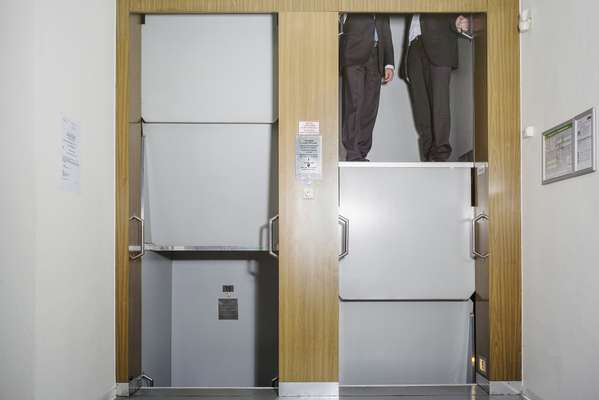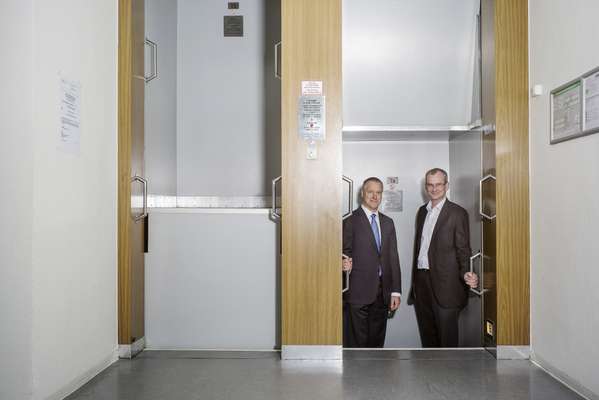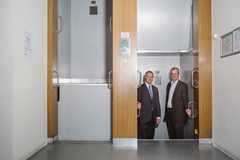Future of the lift / Essen
Going up?
A technological breakthrough for the humble lift is set to elevate our skylines to brand new heights.
Ever since American inventor Elisha Graves Otis came up with a reliable safety brake in 1852, the technology that transports human beings up and down buildings has barely changed. To get 30 people to the 30th floor you still need four essential ingredients: ropes, brakes, a counterweight and a cab. The basics are still the same but that is set to change. A revolutionary moment for the humble lift is approaching. The engineers and researchers at ThyssenKrupp Elevator (one of the four big global lift manufacturers alongside Otis in the US, Finland’s Kone and Switzerland’s Schindler) have come up with a new design that could transform not just the lift industry but also the limits of construction.
“The one-mile-high building is close to becoming a reality,” says head of ThyssenKrupp Elevator’s research centre Markus Jetter, on the top floor (naturally) at the company’s headquarters in Essen. “There are many in planning now. But it’s the elevators that hold these projects back: they’re constrained by our inability to move people up to that height using traditional means.”
Many factors prevent conventional lifts from going higher but the ropes are the main culprit. “After a certain point, the cable becomes so thick and heavy that it can no longer hold its own weight,” says Jetter. “A ropeless elevator would be a gamechanger,” adds his boss, ceo Andreas Schierenbeck.


Their new design, called the Multi, will have no ropes at all and will instead be powered by “linear drive technology”, not dissimilar to the magnetic levitation technology behind some modern trains. This will enable multiple cabs within a single shaft, each able to travel vertically and horizontally, and will move in a circle as if on a huge conveyor belt.
Editors at the industry’s leading publication ElevatorWorld describe the removal of ropes from a lift as nothing short of “the Holy Grail”. But Schierenbeck believes the new design relies on old traditions. “I suppose we’re getting back to our roots in a way,” he says, as he rides up and down in ThyssenKrupp’s old-style paternoster in their HQ.
To really appreciate why the Multi could be so groundbreaking we need to unwrap the historical relationship that lifts have had with buildings. New York is a perfect case study, partly because this is where the lift was invented but also because it is here that it was most fervently adopted and left its most indelible mark. Up until the 1850s, buildings were only built up to about six storeys high: the point at which it was deemed that a person climbing the stairs would throw their shopping bags on the floor and have a tantrum. Otis’s invention made travel in lifts safe and therefore viable on a massive scale. Within decades, office buildings of up to 30 storeys became possible. The corner office of the top floor became the ceo’s domain, the most desirable piece of real estate in the city and a word was newly coined in apartment blocks: “penthouse”.
Arguably, no single invention has played a more decisive role in creating the modern metropolis than the humble lift. During the 20th and into the 21st century, buildings have been getting progressively larger and, as the world urbanises, “super-tall” buildings have become both a physical and financial possibility.
However, in the meantime the lift has fallen from grace. Not only do lifts currently limit the height of buildings but they also require valuable space in super-tall towers, losing developers revenue. In some buildings, up to 40 per cent of floor space is taken up by lift shafts. “It doesn’t feel good to know that you are not keeping pace with your customers,” says Jetter. “We are not ahead of the game at the moment but with the Multi we will be.”
The Multi won’t be properly put to the test until 2016 but Jetter insists that three years in r&d have already proved that the system is workable. If the ThyssenKrupp team do manage to build a system that can do the necessary – contain multiple lifts in one shaft, operate without ropes, maintain safety and provide developers with as many lifts per minute as they need – they will catapult the construction industry to new heights.
Just think: no longer will architects and developers have to factor in huge losses in earnings due to space-hungry lift shafts. Lifts won’t be a constraint on design ambition and the mile-high building won’t be just a fanciful vision of architects’ daydreams. Plus you might not be left in your company’s lobby for 20 minutes pressing the “Call lift” button in vain.


